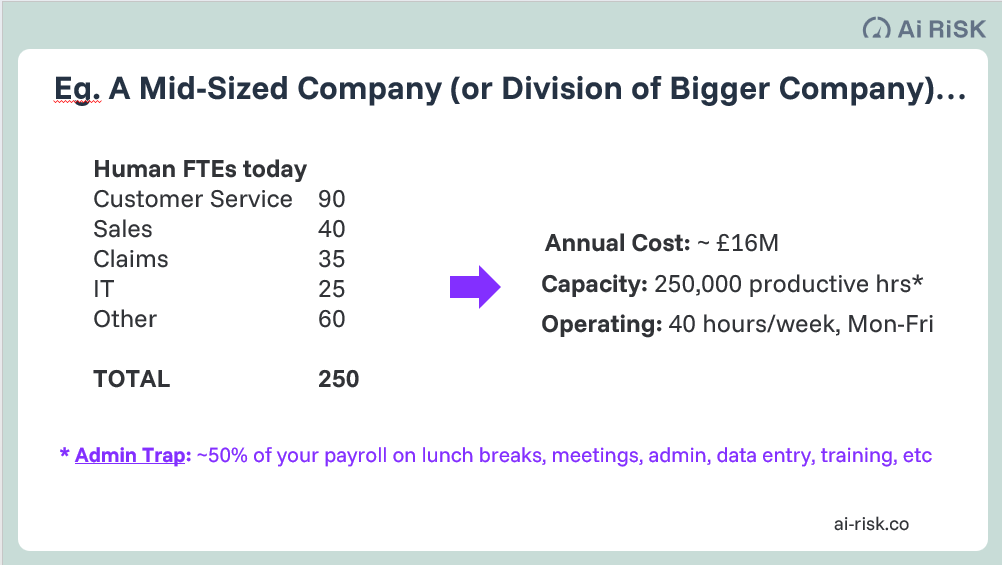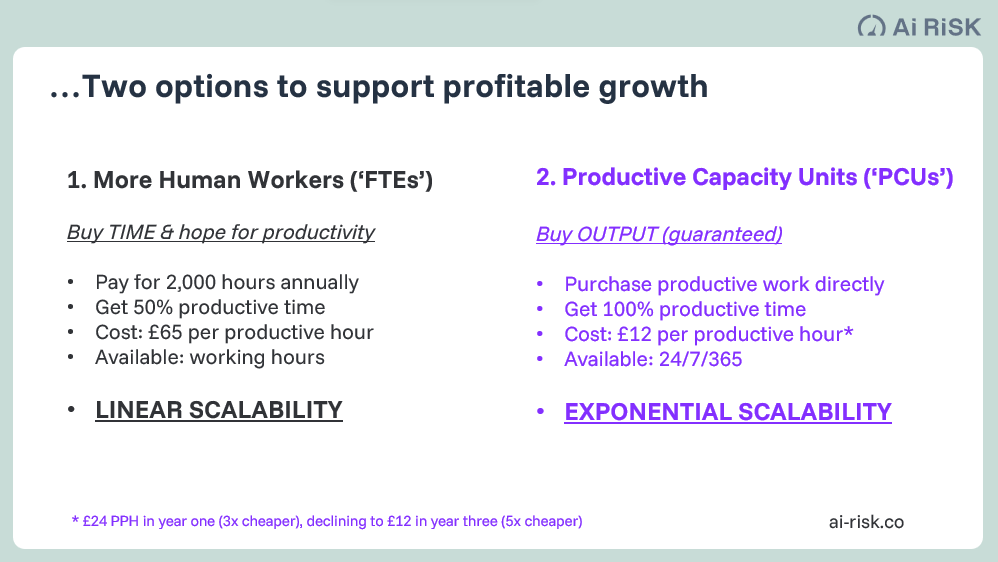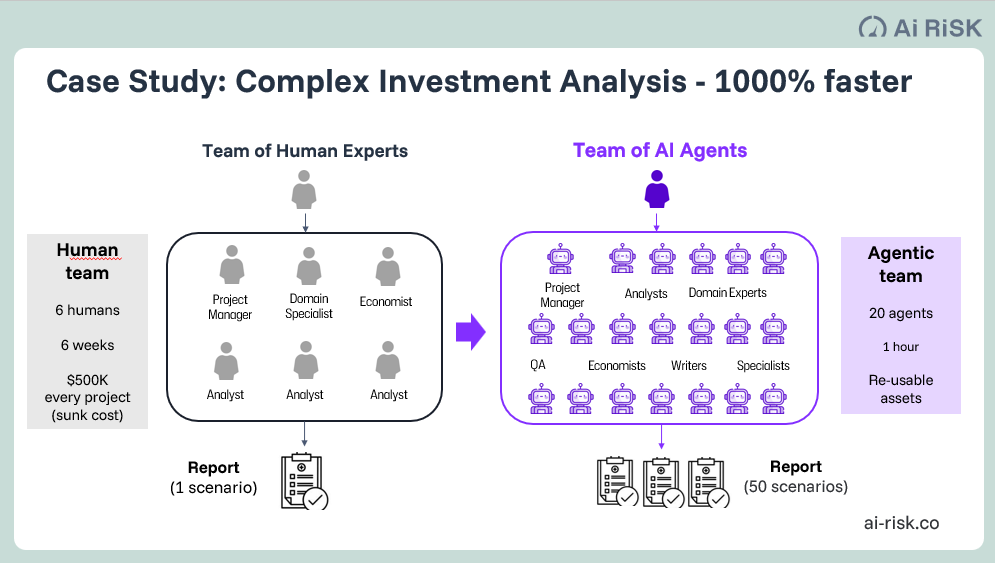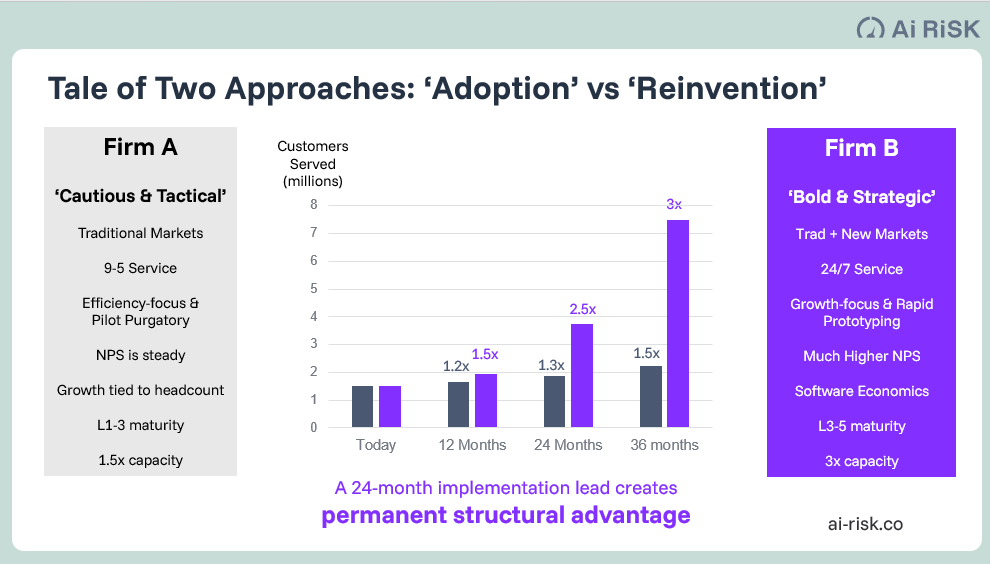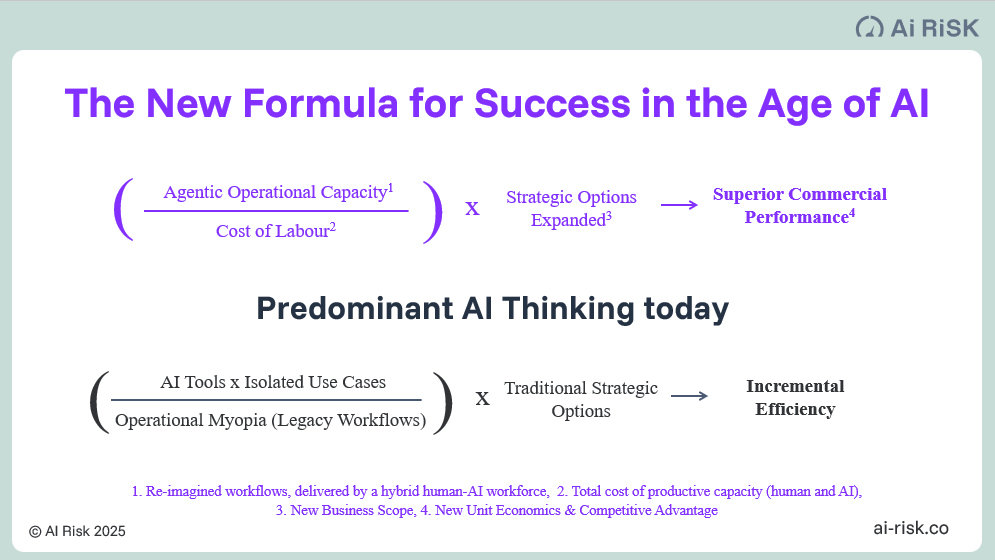Your New Competitive Advantage: ‘Agentic Operational Capacity’
How to Triple Your Output Without Tripling Your Headcount?
This isn't a hypothetical question. It's the strategic choice your leadership team is making right now — through action or inaction.
By 2028, the competitive landscape in knowledge-intensive sectors will have fundamentally restructured. Some firms will operate with 3-5x the operational capacity of their peers, serving markets their competitors can't profitably access. Others will be explaining to their boards why they didn't move when they saw the signals.
The difference? How they answered a single strategic question: If cognitive work capacity could be purchased and scaled like manufacturing capacity — unlimited by human hiring — what business would we build?
Introducing Agentic AI
Agentic AI is the next wave of AI. It’s about deploying AI agents, which are autonomous or semi-autonomous software-based systems that can undertake cognitive tasks that in the past only human workers could do.
When designed well (and very few today know how) they can:
Sense, think, decide, and act to achieve goals — rapidly, intelligently, and at scale. They typically have specific job descriptions and roles, are given certain behaviour traits and have access to specific data.
Collaborate with humans and with other AI agents over everyday enterprise communication tools like Slack or MS Teams.
Be trained very quickly and rapidly learn on the job.
They are auditable, have predictable behaviours and never take a break. Because they are made of software they are infinitely scalable at near-zero marginal cost.
Our AI maturity model, below, shows how Agentic AI is a very different category of AI, quite unlike the productivity ‘tools’ most companies use today to help their people work faster.
The ‘tools’ at Level 0 and 1 are important foundations. But they don't create competitive advantage. Everyone has access to the same tools.
Competitive separation happens at Levels 3 to 5, when autonomous agents start interacting - with each other, with human workers and with the outside world. These are the systems that AI Risk specialises in building for our clients:
Level 3 ‘Multi-Agent Workflows’ are AI systems that autonomously handle complete end-to-end processes. They don’t assist humans — they replace entire workflow steps.
Level 4 ‘Agentic Teams’ refers to swarms of AI agents that work together, coordinate across systems, make decisions, and take action. They learn rapidly from their experiences.
Level 5 ‘Ecosystem Agents’ is when AI agents talk to other AI agents across organisational boundaries, coordinating supply and demand. They enable a new phenomenon called Agentic Commerce.
This is where the two firms in our opening question diverge. Firms optimizing Levels 1-2 get 20% efficiency gains. Firms deploying Level 3-5 get 3-to-10x ‘operational capacity expansion’, enabling them to innovate, drive more customer value and outcompete rivals cost effectively.
Why? Because you're no longer constrained by human hiring.
What's Actually Different This Time?
Every technology wave promises transformation. Most deliver incremental improvement. Here's why this one is categorically different:
For 150 years, scaling knowledge work meant hiring humans slowly. Better tools helped — computers, internet, analytics — but the ceiling remained: growth capped by workforce growth, efficiency gains topped at 30%, expansion required painful hiring or expensive M&A.
Agentic AI removes that constraint entirely.
Cognitive capacity can now be purchased, deployed, and scaled at software economics: capabilities doubling every 6 months, costs dropping 10x annually, near-zero marginal cost per unit. This isn't a tool that makes humans more productive. This is cognitive labour itself.
The pattern shifts from Tool → Human → Output to Capital → Output.
Consider what that means for competitive dynamics.
Making It Concrete: An example of Transformation from the Insurance sector
Let's examine, as an example, a typical mid-sized insurance firm with 250 employees (these principles apply to any company operating in a knowledge-intensive sector, for example financial services, TMT, biotech, professional services):
Standard knowledge work economics for this sort of firm are: £16 million in salaries, 250,000 productive hours annually, operating Monday-Friday, 9-5. But here's the reality — half that payroll covers lunch breaks, meetings, form-filling, data entry, training. This is the "Admin Trap": companies of this type are paying £65 per productive hour after accounting for non-productive time.
Now compare two options for supporting growth:
Human Workers: Buy time, hope for productivity. Linear scalability. Available working hours only.
‘Productive Capacity Units’ (PCUs): a term coined recently by Aalok Yashwant Shukla, referring to AI Agents. You buy output directly. Exponential scalability. Available 24/7/365. In our experience, the ‘Cost Per Productive Hour’ is in the order of 3x cheaper than human workers initially, declining to 5x cheaper within a few years.
The growth dynamics are fundamentally different, per the diagram below:
Traditional hiring: 12-18 months per cycle. Each cycle starts from zero.
Agentic deployment: 1-3 months per cycle. Each cycle builds on the last, unlocking new markets through improved economics.
Here's what this firm looks like by 2028:
Same firm, reinvented: 205 humans in strategic roles, 585 AI agents operating continuously, 790 ‘capacity units’ in total. Salaries down to £12 million. Capacity tripled. Operating 24/7/365.
Notice what happened: 10 employees redeployed into newly critical roles as AI Agent Managers — they may now be the firm's most valuable experts. More humans assigned to product development, sales and distribution, and IT. The agent-to-human ratio reaches nearly 3:1.
This isn't efficiency. This is business model transformation.
The economics that constrained this firm to certain markets now enable the profitable creation of prevention solutions and servicing of vast untapped markets, in particular ‘Insurance Protection Gaps’. Markets that were previously inaccessible become core growth opportunities.
Unlocking Previously Inaccessible Value
Insurance Protection Gaps aren't theoretical markets. These are people and businesses who NEED insurance but can't access it because the economics don't work.
Small businesses that can't afford cyber insurance. Gig workers who can't get health coverage. Homeowners in flood zones who can't get natural catastrophe protection. 40% of European citizens today who don’t have sufficient retirement savings. Overall these ‘gaps’ are worth roughly $350 Billion in Europe alone and around $6 Trillion globally.
This isn't taking market share from competitors. This is creating markets competitors can't access.
Proof: Real Results from Early Implementations
Two of our most advanced case studies demonstrate what's already achievable:
Reinventing Customer Operations for a start-up insurance offering - Agentic Teams Implementation:
FTE hiring: -70%
Net Promoter Score: +25%
Productivity gain: 3x
Profitability: +30%
Employee satisfaction: High (humans elevated to more valuable roles)
The firm deployed agentic teams that handle complex policy and claims operations, working seamlessly with human experts over Slack, who now focus on judgment-intensive decisions and client relationships. Full case study here.
Repetitive Investment Analysis for a Very Large Organisation - Multi-Agent Team:
Time: 6 weeks → 1 hour
Scenarios analysed: 1 → 50
Team composition: 6 humans → 20 AI agents
Cost structure: $500K sunk cost per project → Reusable assets
Result: 1000x efficiency improvement
The agentic team produces more comprehensive analysis — 50 scenarios versus 1 — in a fraction of the time, with capabilities that compound across projects.
Why Most Implementations Fail
These results are real — but they're also very rare today. We find that most firms attempting agentic AI transformation are making the same predictable mistakes:
Mistake 1: Letting IT Drive Agentic AI Strategy
Don't let IT drive this. Your CIO absolutely needs to be at the table — but this isn't an IT project. It's business model reinvention. It requires your CEO and cross-functional leadership working together.
Mistake 2: Automating Legacy Processes
Don't automate legacy processes. Most companies we speak to are asking "how do we use AI to speed up our current workflows?" It’s the wrong question. Those workflows were designed for human limitations. Ask instead: "If cognitive capacity was infinite, what business would we build?" That's the difference between 20-30% efficiency gains and 3-10x operational capacity expansion.
Mistake 3: Using Same-Old Vendors
You can't use the same vendors you've always used. The Big Four, your usual systems integrators or ‘digital developers’ — they don't have the right capabilities yet. The skills to build Level 3-5 agentic systems are extremely rare. They reside in specialized firms like AI Risk, not incumbent consultancies scrambling to learn on your dollar.
Mistake 4: Relying on a Single Hyperscaler or LLM provider
Don't lock yourself into one platform. Microsoft, Google, AWS, Open AI, Anthropic — they're all developing powerful tools, but capabilities are evolving fast. Build a model-agnostic architecture that lets you integrate the best components, or you'll be trapped when the next breakthrough comes from a competitor's platform.
Mistake 5: Underestimating Change Management
Finally, this isn't just a technology challenge. The cases above required both the technical capability to envisage and build the complex systems AND the organizational capability to scale them. Most firms have neither.
The tooling from Microsoft, Google, AWS and specialized vendors is developing at extraordinary pace. Knowledge of how to exploit it strategically remains extremely limited.
This explains why most firms remain stuck in "pilot purgatory" — isolated proofs-of-concept that never scale into transformational capacity. All the mistakes above are based on tactical thinking. Incremental. Safe. Delegated.
So, here's your challenge: If you're in an organization thinking tactically, how do you shift the conversation to strategic? First, you need to diagnose where you are. Then you need language to articulate what strategic looks like.
The Competitive Maths: Why a 24-Month Lead Becomes Permanent
Let’s look at two hypothetical firms, from the same industry (sticking with insurance for now). They have similar capabilities and structures and have access to the same technology.
Firm A approaches this tactically. It is efficiency-focused and ‘adopts’ AI to help it automate what it already does. It suffers ‘pilot purgatory’ in the first few years and and reaches Level 1-3 maturity, eventually.
It treats Agentic AI as an IT project: at first it tries to build solutions in-house, then it tests some small point solutions from innovative vendors in non-mission critical domains. It gets seduced by the claims of larger tech vendors and tries to build agentic systems on top with its traditional IT suppliers.
The question it asks itself throughout is: "How do we make our current operations 30% better?"
The result after 36 months? 1.5x customer growth and perhaps a smaller FTE headcount. Doing a bit more with less - not bad.
Firm B, by contrast, approaches this strategically. It is growth-focused. It sees an opportunity to ‘reinvent’ old processes around the capabilities of Agentic AI and address new market segments. It creates methods and tools to undertake rapid prototyping and infrastructure and governance to safely scale. It reaches Level 3-5 maturity. The CEO leads the transformation. Why wouldn’t she?
The CEO asked: "What business should we build if cognitive capacity was infinite?" The result after 36 months? 3x customer growth.
Look at what happens over time. After 12 months, Firm B is already pulling ahead. After 24 months, the gap is massive. By 36 months, they're serving 7.5 million customers while Firm A is serving 2.25 million.
Firm B’s Board is sceptical. They know that traditional best-in-class insurers grow at 18-23% annually. Yet their company is planning to grow at 44%. How is that realistic?"
Three reasons:
First: They're no longer just competing for the same customers. They're also creating new types of protection solutions and accessing protection gap markets — cyber insurance for SMEs, parametric catastrophe coverage for underinsured homeowners, benefits for gig workers. Markets that were previously unprofitable to serve. They're creating new pools, not stealing from existing ones.
Second: Their unit economics enable profitable serving of customers at price points competitors can't touch. When your cost-to-serve drops 5x, you can profitably write policies your competitors have to decline.
Third: They're not constrained by hiring cycles. Traditional insurers who want to grow faster hit talent bottlenecks — they can't hire underwriters, can't train claims handlers, can't scale compliance teams fast enough. Agentic removes that ceiling entirely.
This isn't hypergrowth from better marketing. This is structural advantage from economics transformation. A 24-month implementation lead creates permanent structural advantage. Same underlying technology. Radically different strategic ambition.
One firm reimagined the business model. The other optimized existing processes.
A 24-month implementation lead creates permanent structural advantage. Outcome: permanent power reallocation in the value chain.
The Reinvention Formula
History — see this analysis of Kodak and Fujifilm — teaches a consistent lesson: unless you reframe work, redeploy capabilities, and build new complementary assets, technology adoption on its own does nothing to stem decline.
Reinvention mindset:
(Agentic Operational Capacity / Cost of Labour) × Strategic Options Expanded = Superior Commercial Performance
Adoption mindset:
(AI Tools × Isolated Use Cases) ÷ Legacy Workflows = Incremental Efficiency
The difference between these formulas is the difference between Firm A and Firm B.
Your action framework
1. REFRAME THE QUESTION
Stop: "How do we make our people more productive?"
Start: "If cognitive capacity was purchasable like computing power — unlimited by hiring — what business would we build?"
This reveals opportunities invisible under adoption: markets you can't serve profitably today, services requiring unavailable capacity, expansion blocked by local talent constraints.
2. LEAD FROM THE TOP, NOT FROM I.T.
This transformation requires CEO-level ownership with cross-functional collaboration — COO, CMO, CHRO, CIO working in concert. IT provides essential infrastructure, but Operations and Strategy must define the business model transformation. Firms that delegate this to IT departments get automation projects. Firms that engage the C-suite get reinvention.
3. MOVE UP THE MATURITY CURVE
Most companies are stuck at Level 1-2 (chatbots, assistants — table stakes). Competitive separation happens at Level 3-5 (Multi-Agent Workflows, Agentic Teams, Ecosystem Agents — transformational capacity). Getting there requires specialist capabilities in both agentic system design and enterprise-scale change management — skills that don't reside in traditional IT departments, hyperscalers or incumbent vendors.
4. BUILD, DON'T RENT
Companies deploying owned agentic infrastructure create appreciating assets. Companies buying AI services rent someone else's appreciating assets.
Build: Capabilities improve 2x every 6 months, costs drop 10x annually → Assets appreciate
Rent: Pay market rates, capture no appreciation
5. MOVE WITH URGENCY
The window is narrow. Competitors deploying today have the potential to move from 50% to 90% automation in 24 months (empirical doubling rates). Starting your pilot when they're at 50%? The gap becomes difficult to bridge.
The Choice Before You
For 150 years, knowledge businesses couldn't scale like factories because cognitive work required humans, accumulated slowly. Agentic AI breaks this constraint.
Cognitive capacity is now purchasable, deployable, scalable like software. Firms recognizing this aren't adopting AI — they're reinventing operating models around agentic operational capacity.
The mathematics is clear: Firms building Level 3-5 agentic operations today will have 3-5x the operational capacity of competitors in three years.
The firms who will win this transformation share three characteristics:
They start within 90 days of recognizing the opportunity
They assemble specialist capabilities in agentic system design and transformation execution
They measure success in capacity expansion, not cost reduction
Whether this transforms the overall economy is debatable. Whether it transforms competitive dynamics in your industry is not.
Our early implementations prove what’s operationally achievable. The question is whether you'll lead the transformation or compete against those who did.
That choice is being made now — through action or inaction.
More on how to take effective action here.





